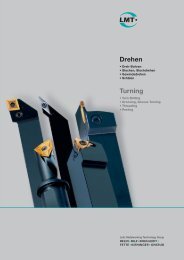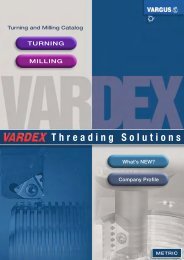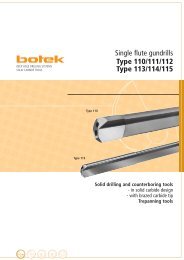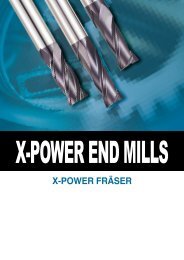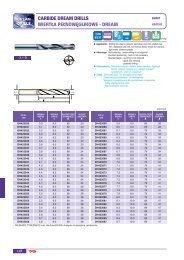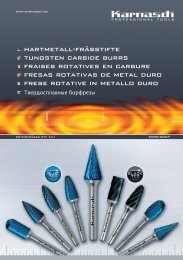Gear Cutting Tools
Hobs - Torion
Hobs - Torion
- No tags were found...
Create successful ePaper yourself
Turn your PDF publications into a flip-book with our unique Google optimized e-Paper software.
Shorter machining times<br />
The machining time (production<br />
time) for the hobbing process is<br />
determined on the one hand by<br />
the gear width and number of<br />
teeth and on the other by the<br />
cutting speed, hob diameter,<br />
number of starts, and axial feed.<br />
The number of starts should always<br />
be increased when the feed<br />
is limited by the depth of the feed<br />
markings before the maximum tip<br />
chip thickness is reached.<br />
The depth of the feed markings is<br />
dependent upon whether the gear<br />
is to be finish-hobbed or subsequently<br />
shaved or ground.<br />
The gear width and the number<br />
of teeth are fixed geometric<br />
values. The cutting speed is<br />
largely dependent upon the gear<br />
material, and its tensile strength<br />
and machineability.<br />
The machining time changes as a<br />
function of the hob diameter,<br />
however. With a small hob diameter<br />
and with the cutting speed<br />
unchanged, the hob spindle and<br />
table speeds increase, and the<br />
machining time is reduced. At the<br />
same time, a reduction in hob diameter<br />
results in a reduction in<br />
the machining distance for axial<br />
machining.<br />
When selecting the hob diameter,<br />
note that the number of gashes is<br />
limited by this dimension, and<br />
that a high number of gashes is<br />
required for good tool life qualities<br />
and lower cutting forces.<br />
The cutter diameter should therefore<br />
only be sufficiently small to<br />
enable a specified cycle time to<br />
be achieved. An unnecessarily<br />
small cutter diameter impairs the<br />
tool life and gear quality.<br />
High axial feeds and multi-start<br />
hobs reduce the machining time<br />
considerably. However, they also<br />
lead to higher tip chip thicknesses,<br />
the increase in which is<br />
influenced more strongly by the<br />
number of starts than by the increased<br />
axial feed.<br />
A relatively high feed should be<br />
selected, and the number of<br />
starts kept as low as possible.<br />
This combination produces the<br />
lowest tip chip thickness. The<br />
two variables are of equal importance<br />
for calculation of the machining<br />
time, i.e. the machining<br />
time is determined by the product<br />
of the feed and the number of<br />
starts.<br />
t h = z 2 · d a0 · π · (E + b + A)<br />
z 0 · f a · v c · 1000<br />
Machining time (production time) for hobbing<br />
t h [min] = machining time<br />
v c [m/min] = cutting speed<br />
z 2<br />
= number of teeth of the<br />
gear to be machined<br />
d a0 [mm] = tip circle diameter<br />
E<br />
b<br />
A<br />
z 0<br />
[mm]<br />
[mm]<br />
[mm]<br />
of the hob<br />
= approach length<br />
of the hob<br />
= tooth width of the gear<br />
to be machined<br />
= idle travel distance of the hob<br />
= number of starts of the hob<br />
f a [mm/WU] = axial feed<br />
δ y [mm] =<br />
z 0<br />
m n<br />
α n<br />
z 2<br />
i =<br />
d<br />
δ y [mm] = π2 · z 2 0 · m n · sinα n<br />
4 · z 2 · i 2<br />
δy<br />
=<br />
=<br />
=<br />
=<br />
envelop cut<br />
deviation<br />
number of starts<br />
of the hob<br />
normal module<br />
profile angle<br />
number of teeth<br />
on the gear<br />
number of gashes<br />
of the hob<br />
Envelop cut deviations<br />
22



